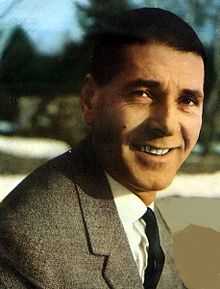Zaim Imamović (musician)
| Zaim Imamović | |
|---|---|
 | |
| Born |
26 August 1920 Mrkonjić Grad, Kingdom of Serbs, Croats and Slovenes |
| Died |
2 February 1994 (aged 73) Sarajevo, Republic of Bosnia and Herzegovina |
| Occupation |
|
| Years active | 1939–94 |
|
Musical career | |
| Genres |
|
| Instruments |
|
| Labels |
|
| Associated acts | |
Zaim Imamović (26 August 1920 – 2 February 1994) was a Bosnian sevdalinka performer, folk singer, accordionist and author.
Biography
He was born in Mrkonjić Grad and after a year his family moved to Travnik and there he lived for fifteen years when, in 1936, he moved to Sarajevo. He lived in Sarajevo for the rest of his life occasionally vacationing in Počitelj where he had a cottage. In Sarajevo he attended textile school and was discovered by a choir leader Cvjetko Rihtman in the cultural society "Gajret" where his sister Đula and his brother Hadžo also sang. When Radio Sarajevo became operational following the liberation of Sarajevo in April 1945, he started performing on and became an employee of Radio Sarajevo, often sleeping under the piano overnight so not to miss the morning telecast.[1][2]
At that time he performed three sevdah songs: "Gledaj me draga", "Konja vodim, pješke hodim" and "Mujo kuje konja po mjesecu" and became very popular (the last of the three songs is one of the most popular sevdah songs ever). His popularity increased in time and he is said to be the best sevdalinka performer of his time and a reformer of the genre. Some of his most popular sevdalinkas are: "Haj, Moščanice vodo plemenita", "Od kako sam sevdah svezo", "Okreni se niz đul-bašču", "Haj, sadih almu na sred Atmejdana", "Ja zagrizoh šareniku jabuku", "Đul Fatima po đul-bašči šeće", "Kad puhnuše sabah-zorski vjetrovi"...
Zaim Imamović was under influence of important sevdah singers of the time: Rešad Bešlagić, Sulejman Đakić, Ibrahim Ašćerić, and others. Together with the he developed an important new style of sevdah singing that was peculiar for radio performance. It was a sharp contrast to earlier singers influenced by bel canto traditions of the European discography market: Bora Janjić, Sofka Nikolić, and others...
Zaim Imamović wrote some of the most popular sevdalinkas: "Sve behara i sve cvjeta", "O, jeseni, tugo moja", "Nesretan sam, majko moja mila", "Kono moja", "Što je lijepo vrelo Mošćanice", "Zašto si me majko rodila"...
He was one of the founders of the Festival Ilidža in Sarajevo. After initial success of the festival to stir up new trends in traditional music, Zaim Imamović retreated from the festival at the beginning of 1970s.
Zaim Imamović died in Sarajevo during the Siege of Sarajevo, on 2 February 1994.
References
- ↑ "Zaim Imamović, najvažnije pjesme". Radio Sarajevo. 19 May 2014. Retrieved 19 November 2014.
- ↑ "Feel the Beauty of Sevdah in Sarajevo". Sarajevo Times. 18 November 2014. Retrieved 19 November 2014.
* Farah Tahirbegović and Damir Imamović, eds. Pjesma srca moga: stotinu najljepših pjesama Zaima Imamovića. Annotated songs and CD. Sarajevo: Buybook publishing house, 2004.
External links
|